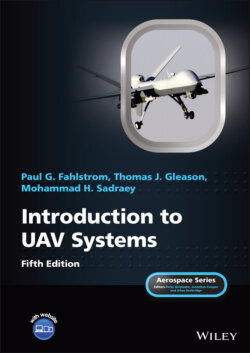Читать книгу Introduction to UAV Systems - Mohammad H. Sadraey - Страница 71
3.4 Airfoil
ОглавлениеThe most important element of a lifting surface (e.g., wing/tail) for aerodynamic purposes is its cross‐section or airfoil. Any section of the wing cut by a plane parallel to the aircraft xz plane is called an airfoil. It usually looks like a positive cambered section where the thicker part is in front of the airfoil. A typical airfoil section is shown in Figure 3.3, where several geometric parameters are illustrated. The leading edge is often curved (for a subsonic air vehicle) and the trailing ledge is sharp.
If the mean camber line is a straight line, the airfoil is referred to as symmetric airfoil; otherwise it is called a cambered airfoil. The camber of airfoil is usually positive.
Two of the most important parameters of an airfoil are camber and the thickness‐to‐chord ratio. The wing/tail is a three‐dimensional component, while the airfoil is a two‐dimensional (2d) section. Because of the airfoil section, two other outputs of the airfoil, and consequently the wing/tail, are drag and pitching moment.
Figure 3.3 Airfoil geometric parameters
Figure 3.4 Infinite span wing
Any particular airfoil cross‐sectional shape has a characteristic set of curves for the coefficients of lift, drag, and moment that depend on the angle of attack and Reynolds number. These are determined from wind tunnel tests and are designated by lowercase subscripts.
Basic aerodynamic data are usually measured from a wing that extends from wall to wall in the wind tunnel, as shown in Figure 3.4. Extending the wing from wall to wall prevents spanwise airflow and results in a true two‐dimensional pattern of air pressure. This concept is called the infinite‐span wing, because a wing with an infinite span could not have air flowing around its tips, creating spanwise flow and disturbing the two‐dimensional pressure pattern that is a necessary starting point for describing the aerodynamic forces on a wing. A real airplane wing has a finite span, and often tapers and twists. The analysis of aerodynamic forces begins with the two‐dimensional coefficients, which then are adjusted to account for the three‐dimensional nature of the real wing.
Figure 3.4 also illustrates a few of the infinite number of streamlines around a wing. A streamline is a curve in the flowfield that is tangent to the local velocity vector at every point along the curve. Upstream of the wing, the flow is uniform with a constant velocity.
In the 1950s, airfoils were classified by the National Advisory Committee for Aeronautics (NACA), the forerunner of the present NASA, and were cataloged using a four/five digits code. The details of NACA airfoils have been presented in a book published by Abbott and Von Donehoff [9]. The NACA airfoils are one of the most common and one of the oldest airfoil families.
Airfoil cross‐sections and their two‐dimensional coefficients were classified in a standard system maintained by the NACA (predecessor of the present National Aeronautics and Space Administration (NASA)) and identified by a NACA numbering system, which is described in most aerodynamic textbooks. Figures 3.5 to 3.7 show the data contained in the summary charts of the NASA database for NACA airfoil 23021 as an example of the information available on many airfoil designs.
Figure 3.5 shows the profile of a cross‐section of this airfoil which has a thickness‐to‐chord ratio of 21%. The x (horizontal) and y (vertical) coordinates of the surface are plotted as x/c and y/c, where c is the chord of the airfoil, its total length from nose to tail.
Two‐dimensional lift and moment coefficients for this airfoil are plotted as a function of angle of attack in Figure 3.6. Two‐dimensional drag and moment coefficients for this airfoil are plotted as a function of the lift coefficient in Figure 3.7. Moments and how they are specified are further discussed in Section 3.5. The moment coefficient in the plot is around an axis located at the quarter‐cord, as mentioned previously.
Figures 3.6 and 3.7 show two curves for each coefficient. Each curve is for a specified Reynolds number (R). The NASA database contains data for more than two Reynolds numbers, but Figures 3.6 and 3.7 reproduced only R = 3.0 × 106 and R = 8.9 × 106. The two moment curves lie nearly on top of each other and are hardly distinguishable.
Figure 3.5 NACA 23021 airfoil profile
Figure 3.6 NACA 23021 airfoil coefficients versus angle of attack
The NASA LRN 1015 (NASA TM 102840) airfoil is used on the Northrop Grumman RQ‐4 Global Hawk (see Figure 1.4) wing. The airfoil maximum thickness is 15.2% at 40% chord, and its maximum camber is 4.9% at 44% chord.
The airfoils used on the MQ‐1 Predator (see Figure 11.1) wing is a proprietary material of General Atomics. However, it is estimated that the airfoil maximum thickness is 10% at 26.6% chord, and its maximum camber is 3.4% at 45.1% chord. The airfoil has a high camber, which provides the desired aerodynamic performance at high Reynolds numbers.
Figure 3.7 NACA 23021 airfoil coefficients versus lift coefficient
With the progress of the science of aerodynamics, there is a variety of techniques and tools to accomplish the time‐consuming job of calculating lift and drag. A variety of tools and software based on aerodynamics and numerical methods have been developed in the past decades. A number of CFD1 Software packages based on Navier‐Stokes equations, the vortex lattice method, and thin airfoil theory are available in the market. The application of such software packages, which is expensive and time‐consuming, at this early stage of wing design seems un‐necessary.
